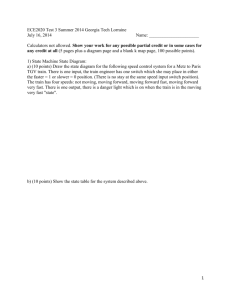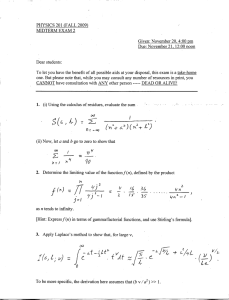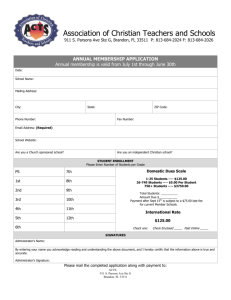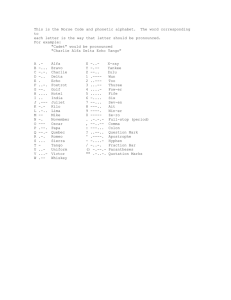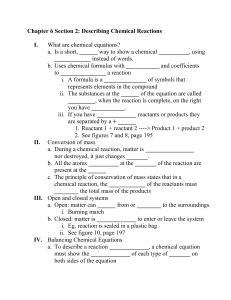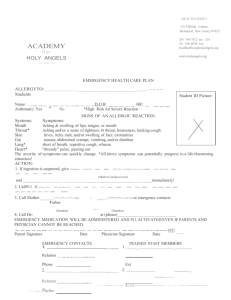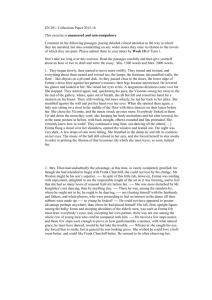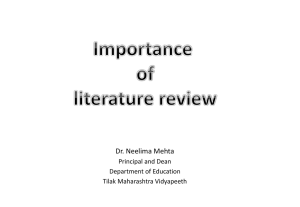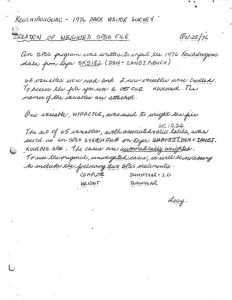kEY
advertisement
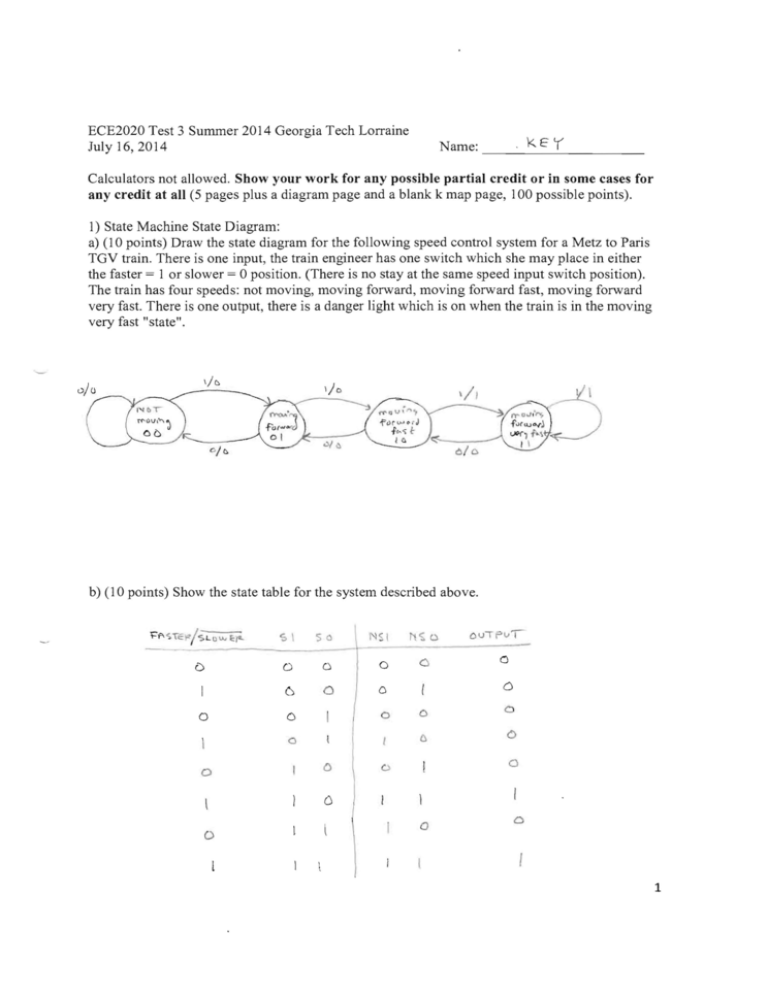
ECE2020 Test 3 Summer 2014 Georgia Tech Lorraine
July 16,2014
, kEY
Name: --------------------
Calculators not allowed. Show your work for any possible partial credit or in some cases for
any credit at all (5 pages plus a diagram page and a blank k map page, 100 possible points).
1) State Machine State Diagram:
a) (10 points) Draw the state diagram for the following speed control system for a Metz to Paris
TGV train. There is one input, the train engineer has one switch which she may place in either
the faster = 1 or slower = 0 position. (There is no stay at the same speed input switch position).
The train has four speeds: not moving, moving forward , moving forward fast, moving forward
very fast. There is one output, there is a danger light which is on when the train is in the moving
very fast "state".
1
2) State machine hardware
a) (lO points) Show the k maps and the resulting Boolean equations to implement the following
state table.
N::: a -,
0 v lPw ~input
SO
NSO
output
0
0
1
0
1
0
1
1
0
0
1
1
0
1,-::'0 -=
G
u, f>oJ' :::'
"'5 0
IN f'"
I !U ~~
I N f' U-I - <;"
So
+-
-t-
or
I
I
50
0
So
Sa
1
litI IN?..,'\" ,
Sa
IN\-,V-r
b) (lO points) Show all the hardware needed in the box below to implement this state machine.
Be sure to include any registers you need.
input
output
2
clkl
clk2
3) (15 points) SIMM Memory Systems
Using SIMMs that are 1 GBytes (one billion addresses by eight bit words):
Part A Suppose that these SIMMS are used to build a 4 billion address memory system with 32
bit words. Answer the following questions about this memory ~stem:
How many address lines does each SIMM require?
2 C> ~7 3 0
30
How many address lines does the entire memory system require?
How many SIMMS are require for the entire memory system?
~
a
"i- 'f 2..
for
Q&<-k
=
~
~o
2. 2..
z,z.
::: 2
Cu",J Y 4- n'''''E5
= "7 '32....... 1- G-'I'>4r~ 5 \0'\1(\
::: 10 S' 1m,"" S
What kind of address decoder is required? _ _2_ _1_0_ _
4_____________
How many memory banks are needed? _ _ _ _+
__6_-_Fl_N_ I----==S'----_ _ _ _ _ _ _ __
3
4) (15 points) Suppose the following inputs (in hexadecimal) are applied to the 32-bit shift unit
used in the single cycle data path shown in the diagram on the last page of the exam. Determine
the output of the shift unit (in hexadecimal). You may assume the "su en" is a one to allow the
shift unit to output a result.
Shift Type (st)
rotate
arithmetic
logical
Shift Amount (count)
OxOOOOOO16
OxOOO1OOOO
OxFFFFFFFF
Input Value
Ox9B4CEF1O
Ox97D3AB2F
OxFFFFFFFF
Output
~ c..4-2..~ ()
OX33
O ~ FFFF-
FFF"r
°XFFFr-FPr-£
Show your work here:
KC TAT f
=;
a '/- 1&,
:
ox
Cj
100\
B, \;: c
0"" !:T <;
4- <..
E
F I
0
\0' \ olEo
~
1100
!II 0
~o
3
3
II, I
0
B
o X I D ODO
(J
u
I
c...
4­
r lIN
t;! \
= ")
l+ !V- (.,. ~
p. ':-'S u
I
() oC()
Tl~ . . . ,"-l
() 000
(> 000
fr·'f' <.Iv '"
/ ".:,
S \-1-1 r-rtN t­
~1
-0 0 0
A
5 '2-
-r r
i
T '
Tv'
~5
O Ne ~
t -; ~
B- ~<; u '-\
i o6-
le"'L
()y
0 0 0 (\
6660
-1-1
oY (,)oOQO()ol
L I:::'-'f' I
8 'I
4
CJ 0 0 C>
5) Using the datapath we have been discussing in class and shown on the last page of the exam
(you may tear off that last page) write the microcode fragm ents to accomplish the following
procedures. Use an "X" when a value is a don't care. You may assume register 0 contains all
zeros. For full credit complete the description field. Less registers used and less steps in your
answers earn more credit. Add more step #s if you need more than is drawn below.
a) (10 points) Write a microcode fragment (lor more microinstructions) that puts the
numerical value of the lower 16 bits of register 5 into register 7.
#
X
Y
1
2
3
4
5
5
X 7
Z
rwe
im
en
I
I
im va
au
en
-a/s
oXO(WIQ F~ - 0
X
lu
en
I
If
su
en
st
st
en
Id
en
r/
-w
msel
1000
()
XI<
C
b
'f
0
description
Rl'
~
Rs ". ... 0
Cl;C~FFFf::"
b) (20 points) Write a microcode fragment (lor more microinstructions) that Exclusive ORs
memory location 5,233 with memory location 5,500 and puts the result in memory location
6,500
#
X
Y
Z
rwe
im
en
1
X
r-
t
,I
2
'f.
'j.
I
\
3
4
5
6
7
8
9
X
im va
au
en
-a/s
lu
en
If
su
en
st
I
S2~3
!
0
0
'10<1'''
0
0
Y­
O
1­
f>
'001
0
0
0
'X
0
'/'j
0
I
I
I
R\ ::: MCS2.3 3]
0
X
0
,
'R l
=­
S'L-S '3
xX
0
'X»X
'/..'f
0
I
I
\
R2 =­ SSD.()
f. 2 :: rn C '5
f...
I
0110
0
1<X
0
0
X
0
PI:::
I
0
0
~)\}f>
0
'x;X
a
6
0
R2 -:::
Co
X
0
'/.Xx'/.
0
'AX
I
(:,
I
rfl CR2J =
I
0
0
"f­
2.
0
X
0
X
1
L
I
I
0
")(
0
';{
~
2­
J
1
<;'So
I
2..­
0
X
0
XX
description
()
';<;00
y..
msel
0
I
,
r/
-w
jxx:><")'
~
,\
)(
Id
en
a
L.
'f
st
en
X
6
I:"
40::]
f:':\ E'! u(l.. 1<."2­
<0<; 0.0
~
\
5
sigll
~:\ t e ll d ~r
----r--------t----r------------,.-------------- ,"c::
regis ter
.
tl1~
__~~----~~----+_----~----~------~---i
lll~lll OlV
T
i~ II
arirll1lletic . .
~
'.
unit
UBi t
~--,,----
log]C;I ~
l:.:11( l iO U ;
X Y
,-'UI
l :~,
(I
:)
[l
'-'
; p~
<.'
-- :
:~
" ·1' :11
sllift
h~;i ca l
.:.1
-
d o",
!
\llli t
--.-~
1 = an thmc-t!('
= r') I ~ :C'
~
- ('Oll n r ,, }ll f l<: righ r
- , ou;:: ;h:i:; ),,[,
6
K MAPS:
IB
B
~
}
IA
Ie
e
A
Ie
~
D
ID
ID IB
IA
B
{1---+---+----l----1
{~~
A
Ie
e
IB
Ie
B
1.
IA
{1----1----------1 A
{~
7
